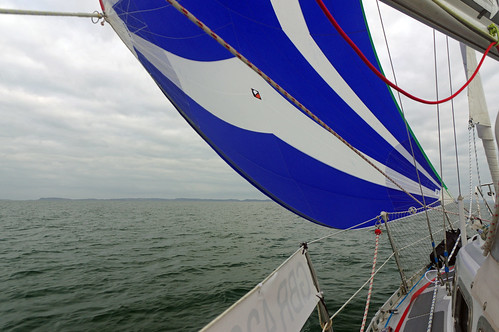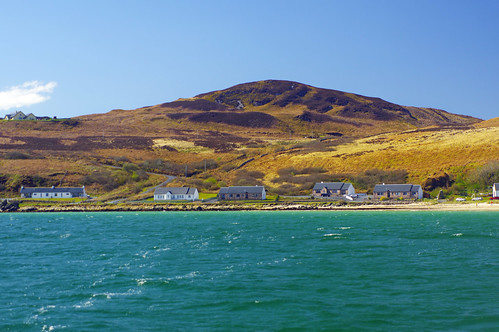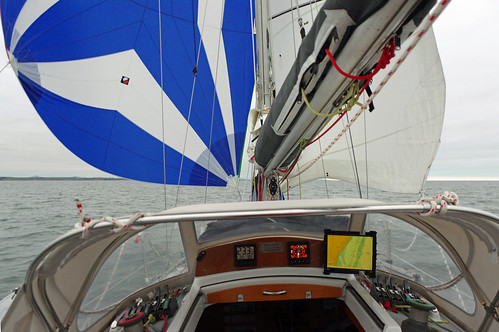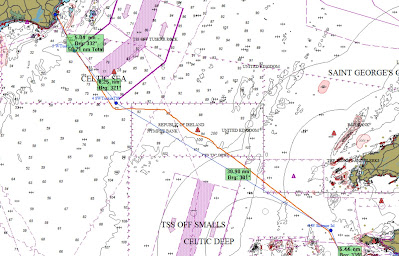I have had a couple of mechanical problems so far, neither expensive to fix but a pain never the less.
The Failed Wind Generator.
Going in towards Milford Haven the generator stopped working, whilst anchored up river I went through the makers fault finding guide which showed that there was probably a break in the cable or a faulty connection. The connection at the regulator was fine so going any further was going to be a challenge, the generator comes with short leads and a piece of chocolate block that you put the main cable onto. The problem is the join is in the support tube so the very heavy unit has to be lifted off to get at it and the cable will have to be cut in the lazarette and pulled through the deck gland to allow the unit to be removed.
When I go to Bangor and had some rest I wrestled it down, as expected not an easy job, the cable join was fine, surprisingly in as good condition as when installed. I partially disassembled the unit and checked the connection between the cable and the output from the electronics and found there was no connection through the positive line. Taking the brush unit off the problem was revealed, a brush broken off at the base, perhaps caused by the rough sea when it failed.
 |
| Only one slip ring brush left. |
Spares are available by post but I have decided to wait until I get home before doing the repair, I remember how difficult it was to put the unit in place and I don't think I can risk doing it without a ladder, also I need to find the broken piece and / or clear out all the debris from the unit which may need it to be taken to pieces which will be much easier on a bench finally having spares sent ahead to a harbour or marina I would have to commit to going to a specific place to pick it up and there always seems to be some delay (Newlyn for the starter motor and my spare prop getting to Stromness in 2020).
.JPG) |
By removing a hatch cover I have found a secure stowage in
the fore peak that does not take up to much space. |
Flooding
Written Monday the 18th.
This became a bit of a saga but briefly, when in Newlyn I found quite a lot of water in the lazarette, I had not noticed it when I put the fenders in leaving Portland but I could not be sure. I pumped it out and it stayed dry for the rest of the time there.
In Milford there was again a lot of water there, although I could not think how water gets there from forward the prime suspect was the recently repacked stern gland which sure enough needed tightening some more. So again I pumped out.
Going across to Ireland the bilge pump was going off fairly frequently so whilst sailing I went headfirst into the quarter berth to check the stern gland, It was not leaking and was still tight but there was a lot of water about and sure enough the lazarette had a lot of water (gallons) in it. I started up the engine and rechecked the stern gland, no water coming from it but water was coming down from above.
Tracking back I found water coming from one of the water hoses, on the outlet side going to the anti-syphon valve between the engine and the exhaust elbow. Fortunately it is a generic hose so easily replaced.
It would appear the water was getting aft by running down the exhaust pipe into the lazarette dropping off as the pipe goes up into the swans neck. Once in the lazarette there was no way back to the main bilge and the automatic pump. Some water went straight down then forward to the bilge. Parts of the engine was covered in salt and not easy to remove in places.
The leak was above the engine where the hose goes through a narrow gap between the engine and the engine box and it had been rubbing on the engine. To make a temporary fix at sea, I had to take front of the engine box to pieces and remove the drawer unit over. I then bandaged the hose up with conforming tape with electric tape over. That has held for the trip up the Irish coast, but I need to fix it properly before leaving Bangor.
Being Easter everything, including the chandler, is closed so it will be Tuesday before I can get some new hose, when I removed the leaking hose and the return which has a rub but not yet leaking, I found it was original (1997) 1/2" car heater hose so if the chandler does not have stock the large automotive spares outlet in town should have some. Fitting will hopefully be straightforward as I have access to both ends and access is relatively easy to route the chose so I am hoping to leave at lunch time tuesday.
I may add some pictures when the fix is done.
Update: Tuesday 19th.
No hose to be had in Bangor! However all was not lost, the anti-syphon valve was mounted on the inboard side of the cockpit locker in the middle of the hatch opening, I found that the two main pipes, but not the drain, would go through an existing hole into the engine compartment mainly used for cables, so I moved the valve c 18" forward to the front of the locker which with a more direct routing allowed me to cut the hoses shorter removing the damaged sections. The route is actually better avoiding some rub points and naturally pushing the hose up and away from the engine. The valve drain hose was fortunately long enough to go back to the original route to the engine bay although I would like it to go further down.

.JPG)

.JPG)
.JPG)
.JPG)

.JPG)



.JPG)
.JPG)


.JPG)
.JPG)
.JPG)
.JPG)

.JPG)
.JPG)

.JPG)



.JPG)


.JPG)
.JPG)
.JPG)





.JPG)

.jpg)
.JPG)





.JPG)
.JPG)
.JPG)

.JPG)
.JPG)

